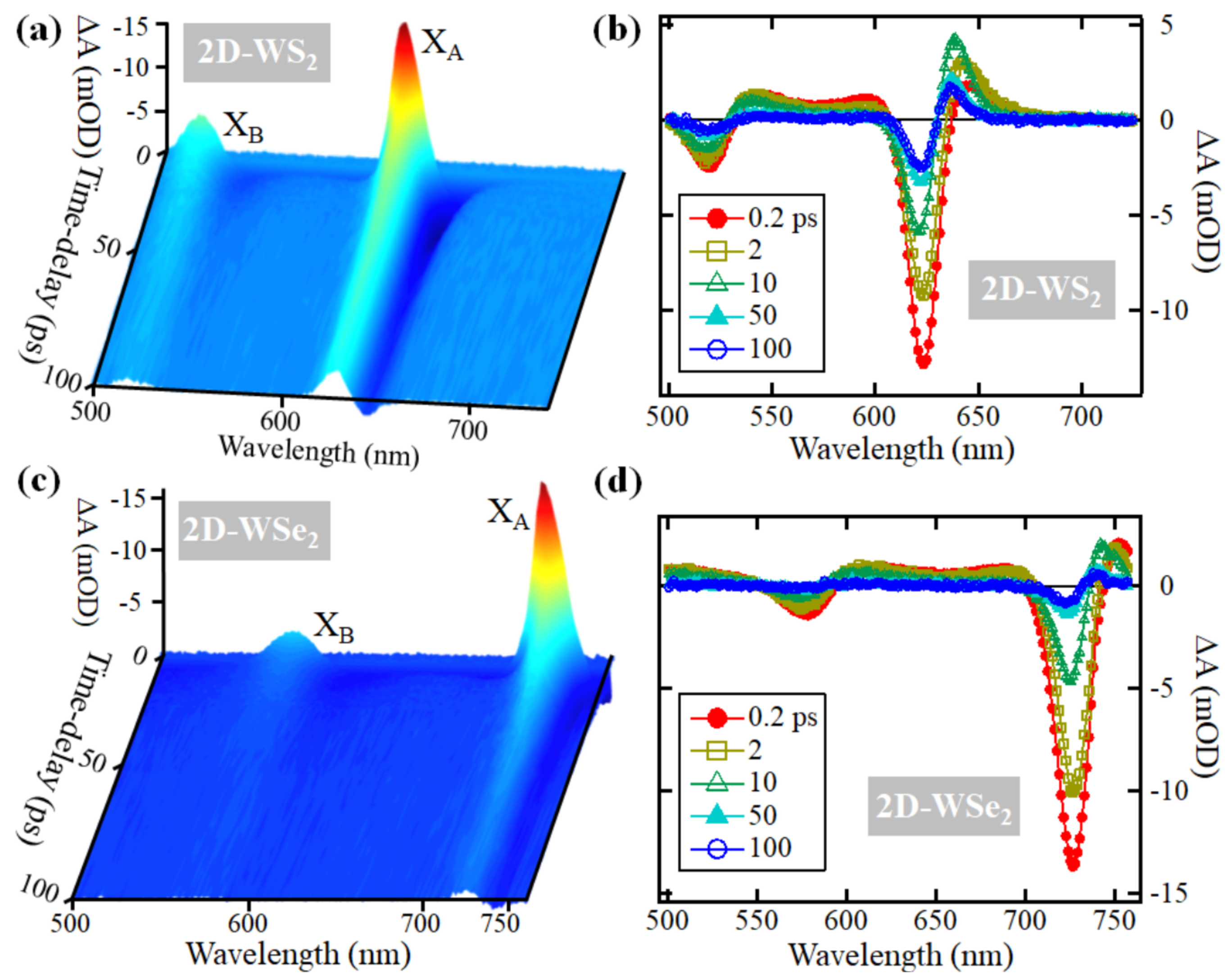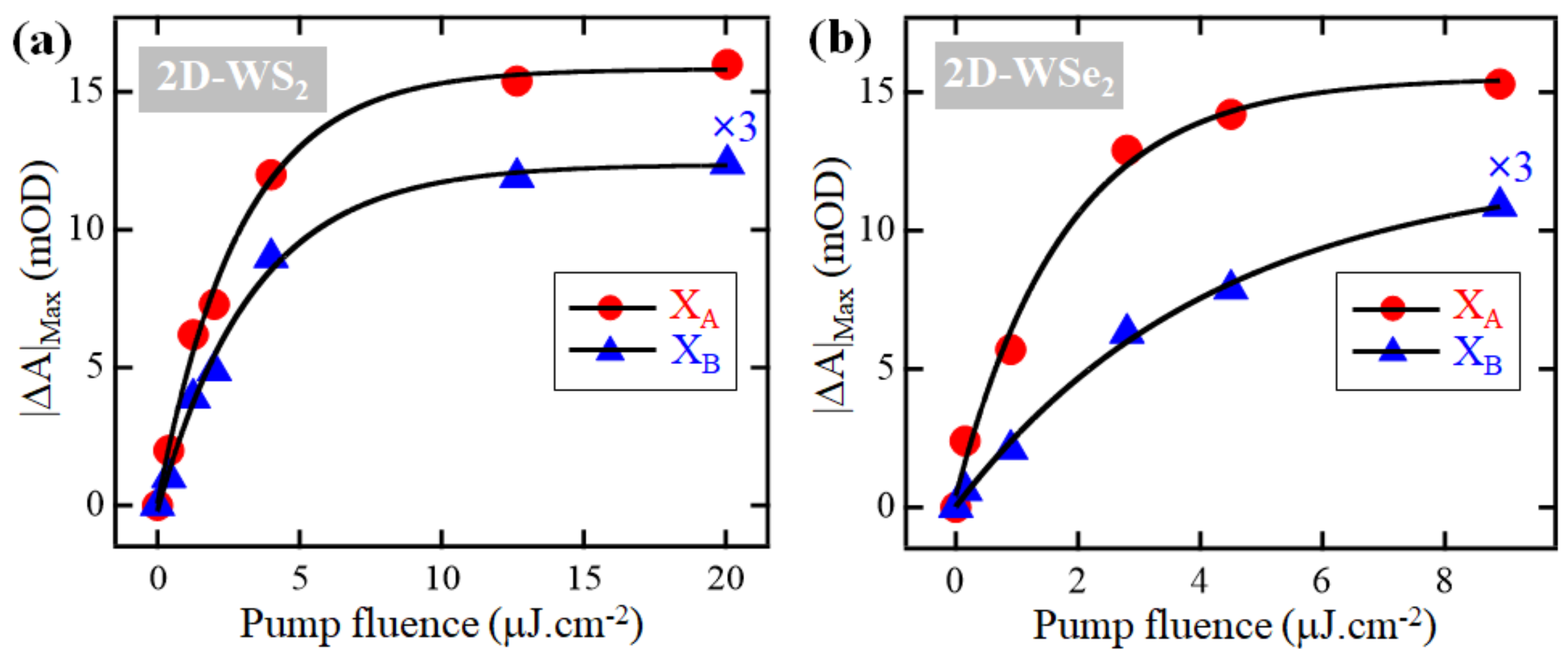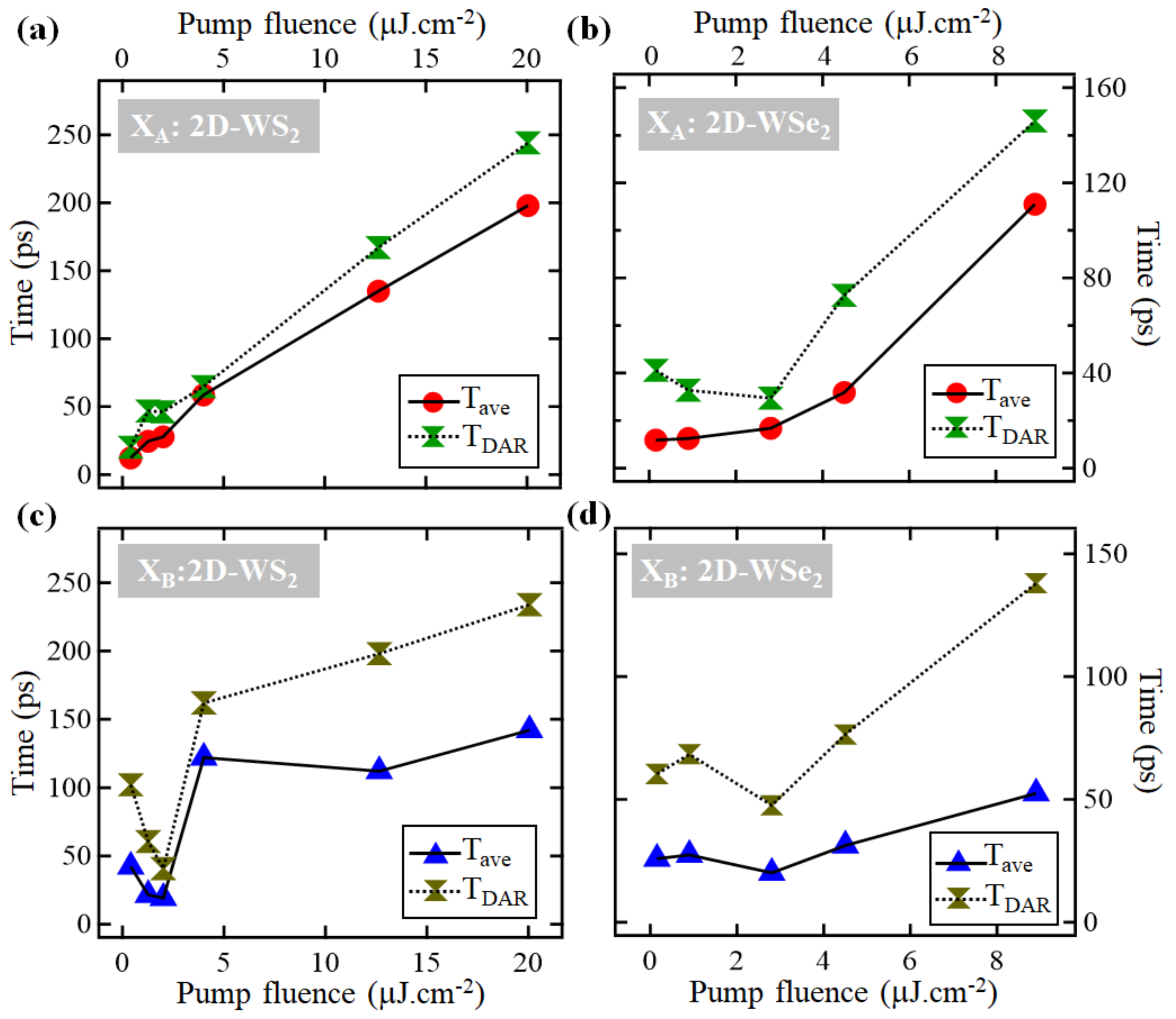Filling Exciton Trap-States in Two-Dimensional Tungsten Disulfide (WS2) and Diselenide (WSe2) Monolayers
Abstract
1. Introduction
2. Materials and Methods
2.1. Subject Material
2.2. Femtosecond Transient Absorption Spectroscopy
2.3. Steady-State Absorption and Emission Spectroscopy
3. Results and Discussion
4. Conclusions
Supplementary Materials
Author Contributions
Funding
Data Availability Statement
Acknowledgments
Conflicts of Interest
References
- Mak, K.F.; Lee, C.; Hone, J.; Shan, J.; Heinz, T.F. Atomically Thin MoS2: A New Direct-Gap Semiconductor. Phys. Rev. Lett. 2010, 105, 136805. [Google Scholar] [CrossRef]
- Splendiani, A.; Sun, L.; Zhang, Y.; Li, T.; Kim, J.; Chim, C.-Y.; Galli, G.; Wang, F. Emerging Photoluminescence in Monolayer MoS2. Nano Lett. 2010, 10, 1271–1275. [Google Scholar] [CrossRef]
- Mueller, T.; Malic, E. Exciton physics and device application of two-dimensional transition metal dichalcogenide semiconductors. NPJ 2D Mater. Appl. 2018, 29, 2. [Google Scholar] [CrossRef]
- Junpeng, L.; Hongwei, L. A critical review on the carrier dynamics in 2D layered materials investigated using THz spectroscopy. Opt. Commun. 2018, 406, 24–35. [Google Scholar]
- Bernardi, M.; Ataca, C.; Palummo, M.; Grossman, J.C. Optical and Electronic Properties of Two-Dimensional Layered Materials. Nanophotonics 2017, 6, 111–125. [Google Scholar] [CrossRef]
- Yuan, L.; Huang, L. Exciton dynamics and annihilation in WS2 2D semiconductors. Nanoscale 2015, 7, 7402–7408. [Google Scholar] [CrossRef] [PubMed]
- Tsai, M.-L.; Su, S.-H.; Chang, J.-K.; Tsai, D.-S.; Chen, C.-H.; Wu, C.-I.; Li, L.-J.; Chen, L.-J.; He, J.-H. Monolayer MoS2 Heterojunction Solar Cells. ACS Nano 2014, 8, 8317–8322. [Google Scholar] [CrossRef]
- Gan, L.-Y.; Zhang, Q.; Cheng, Y.; Schwingenschlögl, U. Photovoltaic Heterojunctions of Fullerenes with MoS2 and WS2 Monolayers. J. Phys. Chem. Lett. 2014, 5, 1445–1449. [Google Scholar] [CrossRef]
- Bernardi, M.; Palummo, M.; Grossman, J.C. Extraordinary Sunlight Absorption and One Nanometer Thick Photovoltaics Using Two-Dimensional Monolayer Materials. Nano Lett. 2013, 13, 3664–3670. [Google Scholar] [CrossRef]
- Bolotsky, A.; Butler, D.; Dong, C.; Gerace, K.; Glavin, N.R.; Muratore, C.; Robinson, J.A.; Ebrahimi, A. Two-Dimensional Materials in Biosensing and Healthcare: From In Vitro Diagnostics to Optogenetics and Beyond. ACS Nano 2019, 13, 9781–9810. [Google Scholar] [CrossRef]
- Liu, X.; Hersam, M.C. 2D materials for quantum information science. Nat. Rev. Mater. 2019, 4, 669–684. [Google Scholar] [CrossRef]
- He, J.; He, D.; Wang, Y.; Cui, Q.; Ceballosb, F.; Zhao, H. Spatiotemporal dynamics of excitons in monolayer and bulk WS2. Nanoscale 2015, 7, 9526–9531. [Google Scholar] [CrossRef]
- Boulesbaa, A.; Babicheva, V.E.; Wang, K.; Kravchenko, I.I.; Lin, M.-W.; Mahjouri-Samani, M.; Jacobs, C.B.; Puretzky, A.A.; Xiao, K.; Ivanov, I.; et al. Ultrafast Dynamics of Metal Plasmons Induced by 2D Semiconductor Excitons in Hybrid Nanostructure Arrays. ACS Photonics 2016, 3, 2389–2395. [Google Scholar] [CrossRef]
- Li, Y.; Qi, Z.; Liu, M.; Wang, Y.; Cheng, X.; Zhang, G.; Sheng, L. Photoluminescence of monolayer MoS2 on LaAlO3 and SrTiO3 substrates. Nanoscale 2014, 6, 15248–15254. [Google Scholar] [CrossRef] [PubMed]
- Chernikov, A.; Berkelbach, T.C.; Hill, H.M.; Rigosi, A.; Li, Y.; Aslan, O.B.; Reichman, D.R.; Hybertsen, M.S.; Heinz, T.F. Exciton Binding Energy and Nonhydrogenic Rydberg Series in Monolayer WS2. Phys. Rev. Lett. 2014, 113, 076802. [Google Scholar] [CrossRef]
- Zhao, W.; Ghorannevis, Z.; Chu, L.; Toh, M.; Kloc, C.; Tan, P.-H.; Eda, G. Evolution of Electronic Structure in Atomically Thin Sheets of WS2 and WSe2. ACS Nano 2012, 7, 791–797. [Google Scholar] [CrossRef]
- He, K.; Kumar, N.; Zhao, L.; Wang, Z.; Mak, K.F.; Zhao, H.; Shan, J. Tightly Bound Excitons in Monolayer WSe2. Phys. Rev. Lett. 2014, 113, 026803. [Google Scholar] [CrossRef] [PubMed]
- Kidd, D.W.; Zhang, D.K.; Varga, K. Binding energies and structures of two-dimensional excitonic complexes in transition metal dichalcogenides. Phys. Rev. B 2016, 93, 125423. [Google Scholar] [CrossRef]
- Boulesbaa, A.; Huang, B.; Wang, K.; Lin, M.-W.; Mahjouri-Samani, M.; Rouleau, C.; Xiao, K.; Yoon, M.; Sumpter, B.; Puretzky, A.; et al. Observation of two distinct negative trions in tungsten disulfide monolayers. Phys. Rev. B 2015, 92, 115443. [Google Scholar] [CrossRef]
- Shi, H.; Yan, R.; Bertolazzi, S.; Brivio, J.; Gao, B.; Kis, A.; Jena, D.; Xing, H.G.; Huang, L. Exciton Dynamics in Suspended Monolayer and Few-Layer MoS2 2D Crystals. ACS Nano 2013, 7, 1072–1080. [Google Scholar] [CrossRef] [PubMed]
- Wang, H.; Zhang, C.; Rana, F. Ultrafast Dynamics of Defect-Assisted Electron−Hole Recombination in Monolayer MoS2. Nano Lett. 2015, 15, 339–345. [Google Scholar] [CrossRef]
- Moody, G.; Schaibley, J.; Xu, X. Exciton dynamics in monolayer transition metal dichalcogenides. J. Opt. Soc. Am. B 2016, 33, C39–C49. [Google Scholar] [CrossRef]
- Cui, Q.; Ceballos, F.; Kumar, N.; Zhao, H. Transient Absorption Microscopy of Monolayer and Bulk WSe2. ACS Nano 2014, 8, 2970–2976. [Google Scholar] [CrossRef] [PubMed]
- Eroglu, Z.E.; Comegys, O.; Quintanar, L.S.; Azam, N.; Elafandi, S.; Mahjouri-Samani, M.; Boulesbaa, A. Ultrafast dynamics of exciton formation and decay in two-dimensional tungsten disulfide (2D-WS2) monolayers. Phys. Chem. Chem. Phys. 2020, 22, 17385–17393. [Google Scholar] [CrossRef] [PubMed]
- Kozawa, D.; Kumar, R.; Carvalho, A.; Amara, K.K.; Zhao, W.; Wang, S.; Toh, M.; Ribeiro, R.M.; Castro Neto, A.H.; Kazunari, M.; et al. Photocarrier relaxation pathway in two-dimensional semiconducting transition metal dichalcogenides. Nat. Commun. 2014, 5, 4543. [Google Scholar] [CrossRef]
- Mouri, S.; Miyauchi, Y.; Toh, M.; Zhao, W.; Eda, G.; Matsuda, K. Nonlinear photoluminescence in atomically thin layered WSe2 arising from diffusion-assisted exciton-exciton annihilation. Phys. Rev. B 2014, 90, 155449. [Google Scholar] [CrossRef]
- Azam, N.; Ahmadi, Z.; Yakupoglu, B.; Elafandi, S.; Tian, M.K.; Boulesbaa, A.; Mahjouri-Samani, M. Accelerated synthesis of atomically-thin 2D quantum materials by a novel laser-assisted synthesis technique. 2D Materials 2019, 7, 015014. [Google Scholar] [CrossRef]
- Le, D.; Barinov, A.; Preciado, E.; Isarraraz, M.; Tanabe, L.; Komesu, T.; Troha, C.; Bartels, L.; Rahman, T.S.; Dowben, P.A. Spin–orbit coupling in the band structure of monolayer WSe2. J. Phys. Condens. Matter 2015, 27, 182201. [Google Scholar] [CrossRef]
- Kośmider, K.; González, J.W.; Fernández-Rossier, J. Large spin splitting in the conduction band of transition metal dichalcogenide monolayers. Phys. Rev. B 2013, 88, 245436. [Google Scholar] [CrossRef]
- Carvalho, A.; Ribeiro, R.M.; Castro Neto, A.H. Band nesting and the optical response of two-dimensional semiconducting transition metal dichalcogenides. Phys. Rev. B 2013, 88, 115205. [Google Scholar] [CrossRef]
- Boulesbaa, A.; Wang, K.; Mahjouri-Samani, M.; Tian, M.; Puretzky, A.A.; Ivanov, I.; Rouleau, C.M.; Xiao, K.; Sumpter, B.G.; Geohegan, D.B. Ultrafast Charge Transfer and Hybrid Exciton Formation in 2D/0D Heterostructures. J. Am. Chem. Soc. 2016, 138, 14713–14719. [Google Scholar] [CrossRef]
- Zeng, H.; Liu, G.B.; Dai, J.; Yan, Y.; Zhu, B.; He, R.; Xie, L.; Xu, S.; Chen, X.; Yao, W.; et al. Optical signature of symmetry variations and spin-valley coupling in atomically thin tungsten dichalcogenides. Sci. Rep. 2013, 3, 1608. [Google Scholar] [CrossRef]
- Bauer, J.; Quintanar, L.S.; Wang, K.; Puretzky, A.A.; Xiao, K.; Geohegan, D.B.; Boulesbaa, A. Ultrafast Exciton Dissociation at the 2D-WS2 Monolayer/Perovskite Interface. J. Phys. Chem. C 2018, 122, 28910–28917. [Google Scholar] [CrossRef]
- Sim, S.; Park, J.; Song, J.-G.; In, C.; Lee, Y.-S.; Kim, H.; Choi, H. Exciton dynamics in atomically thin MoS2: Interexcitonic interaction and broadening kinetics. Phys. Rev. B 2013, 88, 075434. [Google Scholar] [CrossRef]
- Courtade, E.; Semina, M.; Manca, M.; Glazov, M.M.; Robert, C.; Cadiz, F.; Wang, G.; Taniguchi, T.; Watanabe, K.; Pierre, M.; et al. Charged excitons in monolayer WSe2: Experiment and theory. Phys. Rev. B 2017, 96, 085302. [Google Scholar] [CrossRef]
- Sun, D.; Rao, Y.; Reider, G.A.; Chen, G.; You, Y.; Brezin, L.; Harutyunyan, A.R.; Heinz, T.F. Observation of Rapid Exciton−Exciton Annihilation in Monolayer Molybdenum Disulfide. Nano Lett. 2014, 14, 5625–5629. [Google Scholar] [CrossRef]
- Cunningham, P.D.; McCreary, K.M.; Jonker, B.T. Auger Recombination in Chemical Vapor Deposition-Grown Monolayer WS2. J. Phys. Chem. Lett. 2016, 7, 5242–5246. [Google Scholar] [CrossRef] [PubMed]
- Ceballos, F.; Cui, Q.; Bellus, M.Z.; Zhao, H. Exciton formation in monolayer transition metal dichalcogenides. Nanoscale 2016, 8, 11681–11688. [Google Scholar] [CrossRef]
- Hong, X.; Kim, J.; Shi, S.-F.; Zhang, Y.; Jin, C.; Sun, Y.; Tongay, S.; Wu, J.; Zhang, Y.; Wang, F. Ultrafast charge transfer in atomically thin MoS2/WS2 heterostructures. Nat. Nanotechnol. 2014, 9, 682–686. [Google Scholar] [CrossRef] [PubMed]





| PP(μJ·cm−2) | 0.4 | 1.3 | 2.0 | 4.0 | 13 | 20 |
|---|---|---|---|---|---|---|
| A1(%): XA; XB | 71; 62 | 48; 66 | 39; 53 | 10; 27 | 19; 43 | 18; 55 |
| t1(ps): XA; XB | 0.52; 0.90 | 0.43; 0.19 | 0.44; 0.33 | 1.75; 2.30 | 1.42; 0.78 | 1.30; 0.63 |
| A2(%): XA; XB | 15; 33 | 38; 24 | 46; 30 | 77; 67 | 60; 41 | 60; 34 |
| t2(ps): XA; XB | 14.6; 25.0 | 19.4; 14.4 | 19.4; 17.2 | 23.1; 31.5 | 47.6; 50.6 | 71.9; 116 |
| A3(%): XA; XB | 14; 5 | 14; 10 | 15; 17 | 13; 6 | 21; 16 | 22; 11 |
| t3(ps): XA; XB | 67.7; 610 | 121; 171 | 128; 81.8 | 312; 1624 | 508; 575 | 714; 598 |
| TDAR(ps): XA; XB | 40.2; 102 | 46.7; 60.5 | 46.1; 40.6 | 64.8; 162 | 167; 198 | 244; 234 |
| Tave(ps): XA; XB | 12.2; 42.1 | 24.5; 21.4 | 27.8; 19.1 | 58.6; 122 | 135; 112 | 198; 142 |
| PP(μJ·cm−2) | 0.15 | 0.90 | 2.80 | 4.50 | 8.90 |
|---|---|---|---|---|---|
| A1(%): XA; XB | 72; 57 | 64; 63 | 46; 59 | 59; 61 | 24; 64 |
| t1(ps): XA; XB | 0.34; 0.17 | 0.35; 0.30 | 1.70; 1.60 | 3.43; 1.61 | 2.81; 0.98 |
| A2(%): XA; XB | 15; 25 | 25; 29 | 48; 37 | 35; 36 | 61; 29 |
| t2(ps): XA; XB | 4.7; 1.72 | 9.20; 8.10 | 11.2; 13.3 | 21.0; 15.3 | 30.5; 30.4 |
| A3(%): XA; XB | 13; 18 | 11; 8 | 6; 4 | 6; 3 | 15; 7 |
| t3(ps): XA; XB | 83.3; 142 | 86.4; 287 | 175; 365 | 374; 811 | 614; 586 |
| TDAR(ps): XA; XB | 41.2; 60.4 | 32.8; 68.4 | 29.4; 47.6 | 72.7; 76.5 | 146; 138 |
| Tave(ps): XA; XB | 11.8; 25.9 | 12.5; 27.4 | 16.8; 20.1 | 31.8; 31.3 | 111; 52.5 |
Publisher’s Note: MDPI stays neutral with regard to jurisdictional claims in published maps and institutional affiliations. |
© 2021 by the authors. Licensee MDPI, Basel, Switzerland. This article is an open access article distributed under the terms and conditions of the Creative Commons Attribution (CC BY) license (http://creativecommons.org/licenses/by/4.0/).
Share and Cite
Ezgi Eroglu, Z.; Contreras, D.; Bahrami, P.; Azam, N.; Mahjouri-Samani, M.; Boulesbaa, A. Filling Exciton Trap-States in Two-Dimensional Tungsten Disulfide (WS2) and Diselenide (WSe2) Monolayers. Nanomaterials 2021, 11, 770. https://doi.org/10.3390/nano11030770
Ezgi Eroglu Z, Contreras D, Bahrami P, Azam N, Mahjouri-Samani M, Boulesbaa A. Filling Exciton Trap-States in Two-Dimensional Tungsten Disulfide (WS2) and Diselenide (WSe2) Monolayers. Nanomaterials. 2021; 11(3):770. https://doi.org/10.3390/nano11030770
Chicago/Turabian StyleEzgi Eroglu, Zeynep, Dillon Contreras, Pouya Bahrami, Nurul Azam, Masoud Mahjouri-Samani, and Abdelaziz Boulesbaa. 2021. "Filling Exciton Trap-States in Two-Dimensional Tungsten Disulfide (WS2) and Diselenide (WSe2) Monolayers" Nanomaterials 11, no. 3: 770. https://doi.org/10.3390/nano11030770
APA StyleEzgi Eroglu, Z., Contreras, D., Bahrami, P., Azam, N., Mahjouri-Samani, M., & Boulesbaa, A. (2021). Filling Exciton Trap-States in Two-Dimensional Tungsten Disulfide (WS2) and Diselenide (WSe2) Monolayers. Nanomaterials, 11(3), 770. https://doi.org/10.3390/nano11030770








